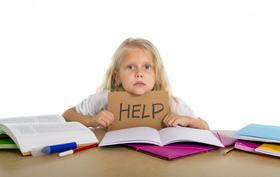Top Rankings
San Juan School District ranks among the top 20% of public school district in Utah for:
Category
Attribute
Diversity
Most diverse schools (Top 1%)
Community Size
Largest student body (number of students) (Top 1%)
Student Attention
Lowest student:teacher ratio (Top 1%)
For the 2025 school year, there are 8 public elementary schools serving 2,205 students in San Juan School District. This district's average elementary testing ranking is 6/10, which is in the top 50% of public elementary schools in Utah.
Public Elementary Schools in San Juan School District have an average math proficiency score of 40% (versus the Utah public elementary school average of 41%), and reading proficiency score of 39% (versus the 42% statewide average).
Minority enrollment is 59% of the student body (majority American Indian), which is more than the Utah public elementary school average of 30% (majority Hispanic).
Overview
This School District
This State (UT)
# Schools
11 Schools
790 Schools
# Students
2,923 Students
416,794 Students
# Teachers
172 Teachers
19,780 Teachers
Student : Teacher Ratio
17:1
17:1
District Rank
San Juan School District, which is ranked within the top 50% of all 153 school districts in Utah (based off of combined math and reading proficiency testing data) for the 2020-2021 school year.
The school district's graduation rate of 91% has increased from 85% over five school years.
Overall District Rank
#61 out of 154 school districts
(Top 50%)
(Top 50%)

Math Test Scores (% Proficient)
(20-21)42%
39%
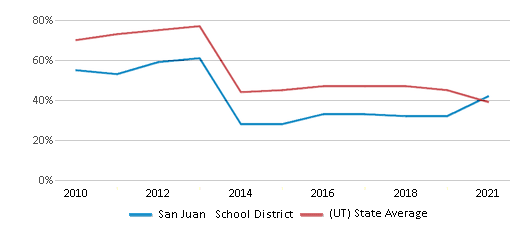
Reading/Language Arts Test Scores (% Proficient)
(20-21)41%
43%
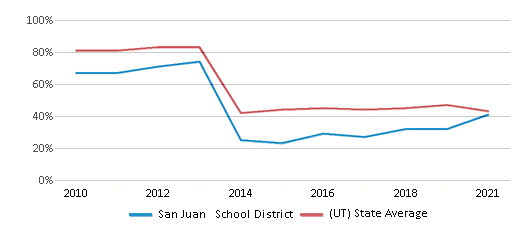
Science Test Scores (% Proficient)
(20-21)50%
45%
Graduation Rate
91%
88%
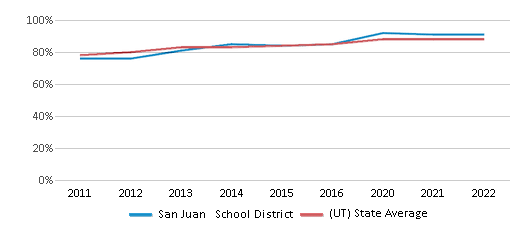
Students by Ethnicity:
Diversity Score
0.58
0.47
# American Indian Students
1,562 Students
4,113 Students
% American Indian Students
53%
1%
# Asian Students
4 Students
7,043 Students
% Asian Students
n/a
2%
# Hispanic Students
198 Students
84,156 Students
% Hispanic Students
7%
20%
# Black Students
5 Students
5,549 Students
% Black Students
n/a
1%
# White Students
1,067 Students
292,437 Students
% White Students
37%
70%
# Hawaiian Students
2 Students
6,780 Students
% Hawaiian Students
n/a
2%
# Two or more races Students
85 Students
16,616 Students
% of Two or more races Students
3%
4%
Students by Grade:
# Students in PK Grade:
108
11,716
# Students in K Grade:
178
44,583
# Students in 1st Grade:
194
47,327
# Students in 2nd Grade:
213
50,032
# Students in 3rd Grade:
229
50,137
# Students in 4th Grade:
196
50,477
# Students in 5th Grade:
227
51,752
# Students in 6th Grade:
224
50,580
# Students in 7th Grade:
219
23,034
# Students in 8th Grade:
240
17,432
# Students in 9th Grade:
238
5,044
# Students in 10th Grade:
222
4,605
# Students in 11th Grade:
231
4,803
# Students in 12th Grade:
204
5,272
# Ungraded Students:
-
-
District Revenue and Spending
The revenue/student of $20,036 is higher than the state median of $10,732. The school district revenue/student has stayed relatively flat over four school years.
The school district's spending/student of $18,052 is higher than the state median of $10,829. The school district spending/student has stayed relatively flat over four school years.
Total Revenue
$59 MM
$7,309 MM
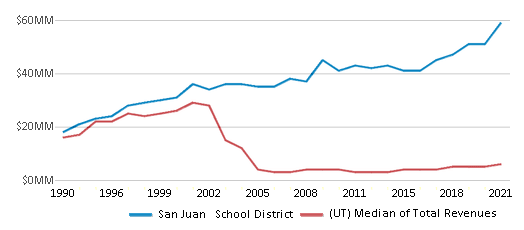
Spending
$53 MM
$7,375 MM
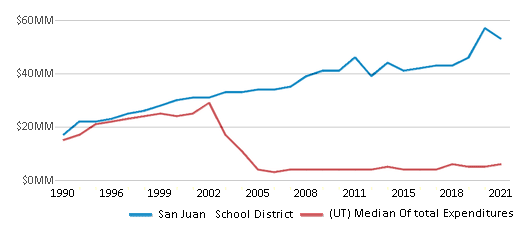
Revenue / Student
$20,036
$10,732
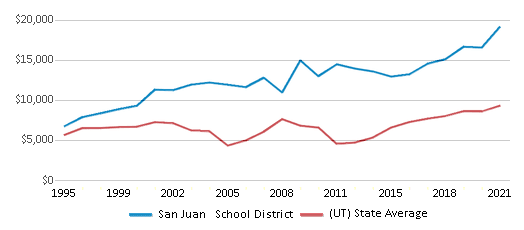
Spending / Student
$18,052
$10,829
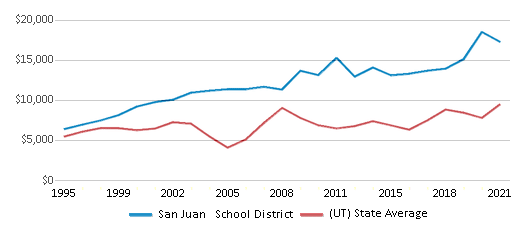
Best San Juan School District Public Elementary Schools (2025)
School
(Math and Reading Proficiency)
(Math and Reading Proficiency)
Location
Grades
Students
Rank: #11.
Monticello School
(Math: 55-59% | Reading: 40-44%)
Rank:
Rank:
8/
Top 30%10
197 N 200 W, 197 N 200 W
Monticello, UT 84535
(435) 678-1180
Monticello, UT 84535
(435) 678-1180
Grades: PK-6
| 305 students
Rank: #22.
Blanding School
(Math: 40% | Reading: 37%)
Rank:
Rank:
5/
Bottom 50%10
302 S 100 W
Blanding, UT 84511
(435) 678-1871
Blanding, UT 84511
(435) 678-1871
Grades: PK-5
| 543 students
Rank: #33.
Albert R. Lyman Middle School
(Math: 36% | Reading: 39%)
Rank:
Rank:
5/
Bottom 50%10
535 N 100 E
Blanding, UT 84511
(435) 678-1398
Blanding, UT 84511
(435) 678-1398
Grades: 6-8
| 323 students
Rank: #44.
San Juan High School
(Math: 25-29% | Reading: 40-44%)
Rank:
Rank:
4/
Bottom 50%10
311 N 100 E
Blanding, UT 84511
(435) 678-1301
Blanding, UT 84511
(435) 678-1301
Grades: 6-12
| 426 students
Rank: #55.
Bluff School
(Math: 30-39% | Reading: 20-29% )
Rank:
Rank:
2/
Bottom 50%10
620 E Black Locust Ave
Bluff, UT 84512
(435) 678-1296
Bluff, UT 84512
(435) 678-1296
Grades: PK-5
| 88 students
Rank: #66.
La Sal School
(Math: ≥50% | Reading: ≥50% )
Rank:
Rank:
1/
Bottom 50%10
885 E Highway 46
La Sal, UT 84530
(435) 678-1292
La Sal, UT 84530
(435) 678-1292
Grades: PK-3
| 10 students
Rank: #77.
Montezuma Creek School
(Math: 15-19% | Reading: 15-19% )
Rank:
Rank:
1/
Bottom 50%10
1466 Hwy 162
Montezuma Creek, UT 84534
(435) 678-1261
Montezuma Creek, UT 84534
(435) 678-1261
Grades: PK-6
| 285 students
Rank: #88.
Tse'bii'nidzisgai School
(Math: 10-14% | Reading: 10-14% )
Rank:
Rank:
1/
Bottom 50%10
101 W Medical Dr, Po Box 36044
Monument Valley, UT 84536
(435) 678-1286
Monument Valley, UT 84536
(435) 678-1286
Grades: PK-6
| 225 students
Recent Articles
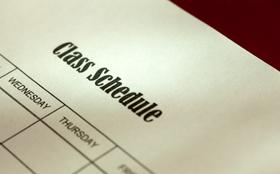
Year-Round Or Traditional Schedule?
Which is more appropriate for your child? A year-round attendance schedule or traditional schedule? We look at the pros and cons.

Why You Should Encourage Your Child to Join a Sports Team
Participating in team sports has a great many benefits for children, there is no doubt. In this article you will learn what those benefits are.

White Students are Now the Minority in U.S. Public Schools
Increasing birth rates among immigrant families from Asia and Central and South America, combined with lower birth rates among white families, means that for the first time in history, public school students in the United States are majority-minority. This shift in demographics poses difficulties for schools as they work to accommodate children of varying language abilities and socio-economic backgrounds.


